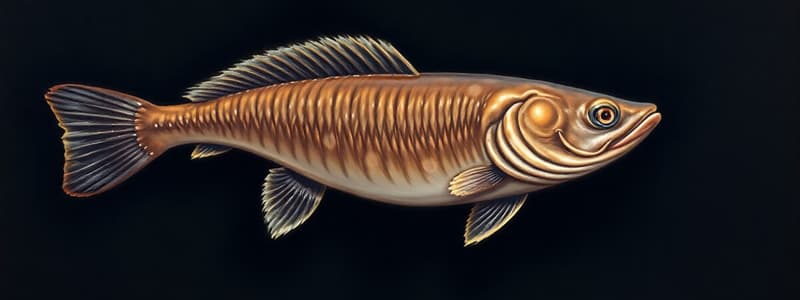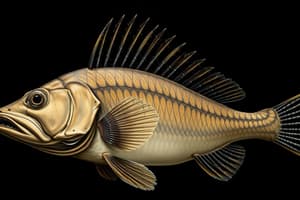Podcast
Questions and Answers
What is the primary reason hagfishes are known as slime eels?
What is the primary reason hagfishes are known as slime eels?
- They inhabit both fresh and marine waters.
- They produce a large amount of slime for protection against predators. (correct)
- Their bodies are shaped like eels.
- They have a unique method of locomotion.
Which of the following characteristics is NOT true about hagfishes?
Which of the following characteristics is NOT true about hagfishes?
- They primarily feed on marine invertebrates.
- They have a terminal mouth.
- They possess gill slits.
- They have a larval stage. (correct)
Where do fresh water lampreys typically lay their eggs?
Where do fresh water lampreys typically lay their eggs?
- In fresh water. (correct)
- In brackish water.
- In marine environments.
- In cold seawater depths.
What distinguishes the feeding habits of hagfishes?
What distinguishes the feeding habits of hagfishes?
Which of the following descriptions is accurate regarding the habitat of hagfishes?
Which of the following descriptions is accurate regarding the habitat of hagfishes?
What is a defining characteristic of Cyclostomata?
What is a defining characteristic of Cyclostomata?
Which of the following accurately describes the circulatory system of Cyclostomata?
Which of the following accurately describes the circulatory system of Cyclostomata?
What feeding behavior do hagfish exhibit?
What feeding behavior do hagfish exhibit?
How many gill openings do Cyclostomata typically have?
How many gill openings do Cyclostomata typically have?
What type of skeleton do Cyclostomata possess?
What type of skeleton do Cyclostomata possess?
Which of the following is a feature of the lamprey's morphology?
Which of the following is a feature of the lamprey's morphology?
What is the primary reproductive characteristic of hagfish?
What is the primary reproductive characteristic of hagfish?
Which statement about the respiratory structure of Cyclostomata is true?
Which statement about the respiratory structure of Cyclostomata is true?
Flashcards
Agnatha (Cyclostomata)
Agnatha (Cyclostomata)
Superclass of jawless fish, including lampreys and hagfish, characterized by their lack of jaws, round mouths with teeth and suckers, and cartilaginous skeletons.
Cephalaspidomorphi
Cephalaspidomorphi
The class of jawless fish that includes lampreys, known for their parasitic nature and feeding on fish blood and tissue.
Pteraspidomorphi
Pteraspidomorphi
The class of jawless fish that includes hagfish, known for their slimy bodies and scavenging lifestyle in the ocean.
Hyperoartia
Hyperoartia
Signup and view all the flashcards
Hyperotreti
Hyperotreti
Signup and view all the flashcards
Agnatha Respiration
Agnatha Respiration
Signup and view all the flashcards
Agnatha Circulation
Agnatha Circulation
Signup and view all the flashcards
Agnatha Digestion
Agnatha Digestion
Signup and view all the flashcards
Larval stage
Larval stage
Signup and view all the flashcards
Lampreys
Lampreys
Signup and view all the flashcards
Hagfish
Hagfish
Signup and view all the flashcards
Direct development in Hagfish
Direct development in Hagfish
Signup and view all the flashcards
Slime defense in Hagfish
Slime defense in Hagfish
Signup and view all the flashcards
Study Notes
Superclass Agnatha (Cyclostomata)
- Agnatha (Cyclostomata) evolved around 500 million years ago
- Once a large group, now many are extinct, except for lampreys and hagfish
- Found in deep marine waters of tropical seas and shallow temperate zones
- Primarily parasitic, feeding on fish as adults
- Resemble eels
- Lack true jaws, hence the name Agnatha
Agnatha Classification
-
Class Cephalaspidomorphi - Hyperoartia - Lampreys:
- Found in both marine and freshwater environments
- Predatory, feeding on fish blood and tissue
- Have a ventral mouth with numerous horny teeth
- Nostrils are located dorsally
- Possess a well-developed dorsal fin
- Development is indirect; they have a larval stage
-
Class Pteraspidomorphi - Hyperotreti (Myxiniformes) - Hagfish:
- Exclusively marine, found in cold seawater at depths up to 1300 meters
- Live on soft bottoms, in burrows
- Feed on invertebrates, dead or crippled fish
- May bore into fish bodies
- Lack a buccal cavity
- Terminal nostrils
- 6-14 pairs of gill slits
- Eggs are few and large
- May lack or have weak dorsal fins
- Direct development (no larval stage)
Agnatha Characteristics
- Body is round and elongated, resembling an eel
- Mouth has rows of teeth and suckers
- Endoskeleton is cartilaginous, with a notochord throughout their lives
- Odd fins (dorsal and caudal), but lack paired fins
- Soft, smooth skin without scales
- Respiration through gills, with 6-14 pairs of gill openings
- Heart is two-chambered
- Digestive system includes teeth, a sucker, pharynx, intestines, stomach, pancreas, liver and gallbladder, opening into intestines and anus
- Paired mesonephric kidneys for excretion
- Brain with about 10 pairs of cranial nerves; lateral line is a sensory organ
- Separate sexes; some hagfish species may be hermaphroditic
- Development may be direct or indirect
- Secrete large amounts of slime for protection from predators
Studying That Suits You
Use AI to generate personalized quizzes and flashcards to suit your learning preferences.




